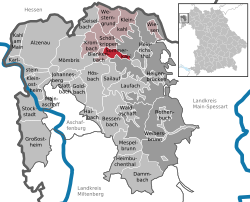Sommerkahl
| Sommerkahl | ||
|---|---|---|

Sommerkahl with parish church, view from the east
|
||
|
||
| Coordinates: 50°04′N 9°16′E / 50.067°N 9.267°ECoordinates: 50°04′N 9°16′E / 50.067°N 9.267°E | ||
| Country | Germany | |
| State | Bavaria | |
| Admin. region | Unterfranken | |
| District | Aschaffenburg | |
| Municipal assoc. | Schöllkrippen | |
| Government | ||
| • Mayor | Arnold Markert (CSU) | |
| Area | ||
| • Total | 5.46 km2 (2.11 sq mi) | |
| Elevation | 226 m (741 ft) | |
| Population (2015-12-31) | ||
| • Total | 1,149 | |
| • Density | 210/km2 (550/sq mi) | |
| Time zone | CET/CEST (UTC+1/+2) | |
| Postal codes | 63825 | |
| Dialling codes | 06024 | |
| Vehicle registration | AB | |
| Website | www.gemeinde-sommerkahl.de | |
Sommerkahl is a community in the Aschaffenburg district in the Regierungsbezirk of Lower Franconia (Unterfranken) in Bavaria, Germany and a member of the Verwaltungsgemeinschaft (municipal association) of Schöllkrippen. It has a population of around 1,100.
Sommerkahl is located in the Mittelgebirge Spessart, in the valley known as Kahlgrund, northeast of Aschaffenburg and not far from the border between the states of Bavaria and Hesse.
The community’s Ortsteile are Sommerkahl and Vormwald.
Sommerkahl was first mentioned in 1184. The oldest part of the settlement is Untersommerkahl, around the Böhmerhof. Obersommerkahl and Vormwald followed in late medieval times.
In 1542, the Archbishop of Mainz, Albrecht granted a permit to mine ore in Sommerkahl. Kupferschiefer was mined for copper. The first period of mining here ended during the Thirty Years' War.
It was resumed in the second half of the 17th century. 42 out of a total 50 claims active at the time in the Spessart region were located in the upper Kahl valley, 11 of them in Sommerkahl.
From the late 19th century, the Grube Wilhelmine was active with copper being mined in several tunnels. Today, access is limited to a depth of around 23 meters, but when active, mining took place at up to 40 meters. Further mining took place at 60 meters and at least one pit reached 80 meters. These tunnels are now flooded. Boosted temporarily by a dearth of commodities during World War I, mining here ceased in 1922.
The council is made up of 13 council members, counting the part-time mayor.
(as at municipal election held on 3 March 2002)
...
Wikipedia



